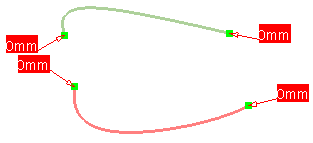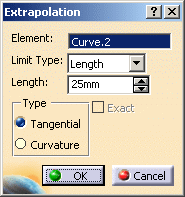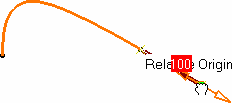 |
This task explains how to modify a curve, or
surface boundary, by extrapolation,
that is by modification of its length. It can be a positive or negative
extrapolation meaning that you can actually lengthen or shorten the curve. |
 |
Open the
FreeStyle_Part_51.CATPart document. |
 |
-
Select the curve to be extrapolated.
It will be extrapolated on the end-point side closest to the selection
point.
-
Click Styling Extrapolate
 . .
|
| |

|
|
The Extrapolation dialog box is displayed.
 |
- Element: Select the element to be extrapolated.
- Limit Type: Two options are available:
- Length: Specify the length for extrapolation.
- Up To: Specify the element up to which you want
the input element to be extrapolated. You can select a curve,
plane or surface.
- Length: This field is displayed if Length
option is selected in the Limit Type list. Enter the
extrapolation length.
- Type: Two options are available:
- Tangential: the surface is extended along the tangent to
the surface on the selected boundary and of a given distance (G1
continuity).
- Curvature: the surface is extrapolated by the specified
value, complying with the surface curvature (G2 continuity). No
manipulator is displayed.
- Exact: This option is not available for curves.
|
|
-
Select the Tangential option:
The curve is extrapolated taking into account the keyed in length
(expressed in model units).
Here we keyed in 100.
|
|
| |

|
|
|
If you key in a negative value, the resulting curve is created in the
other direction.
|
|
| |

|
|
|
-
Click OK to create the extrapolated curve.
|
|
 |
- You can also use the manipulators to interactively modify the value.
- The curvilinear length of the extrapolation is displayed.
- Capabilities are available from:
- the contextual menu when right-clicking an end point.
- the dashboard: auto detection, attenuation,
Temporary Analysis
|
![]()
![]()